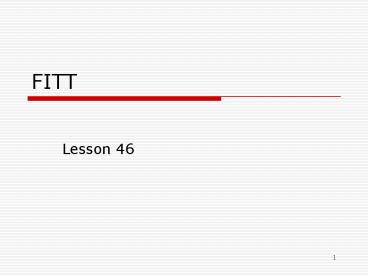FITT - PowerPoint PPT Presentation
1 / 30
Title:
FITT
Description:
FITT Lesson 46 * Your Exercise Prescription Exercise prescription is the dose of exercise you need to maintain a high level of fitness. Exercise prescription ... – PowerPoint PPT presentation
Number of Views:521
Avg rating:3.0/5.0
Title: FITT
1
FITT
- Lesson 46
2
Your Exercise Prescription
- Exercise prescription is the dose of exercise
you need to maintain a high level of fitness.
The factors of an exercise prescription are
referred to as FITT.
3
(No Transcript)
4
Your Exercise Prescription
F
requency how often you work.
I
ntesity how hard you work.
T
ime the length of time, or duration, that you
work.
T
ype the specific type or mode of activity you
choose.
5
Your Exercise Prescription
- Exercise prescriptions are governed by the
specificity principle, the progression principle,
and the overload principle.
You will learn about the principles of
specificity and progression in Lessons 3 and 4.
6
Your Exercise Prescription
- These scientific principles are applied to an
exercise program by adjusting all the FITT
factors in your prescription.
The first FITT factor is frequency.
7
Your Exercise Prescription
- Frequency considerations are
- Your specific fitness goals. One basic goal
should be cardiovascular conditioning
- Your current level of fitness.
- Other priorities and responsibilities in your
daily life.
8
Your Exercise Prescription
- The second FITT factor is intensity.
9
Your Exercise Prescription
- For cardiovascular conditioning, a reliable
measure of intensity is a percentage of your
maximum heart rate.
10
Your Exercise Prescription
- Another method of determining intensity is using
perceived exertion or Ratings of Perceived
Exertion (RPE).
RPE are based on your awareness of specific body
cues such as how hard you are breathing, your
heart rate, or body temperature.
11
(No Transcript)
12
Your Exercise Prescription
- Another method for monitoring your intensity is
the talk test.
13
Your Exercise Prescription
- For weight training, a useful gauge of intensity
is a percentage of your maximum strength. - Maximum strength is a measure of how much weight
you can lift one time for a given exercise.
14
Your Exercise Prescription
- The third FITT factor is time.
- A workout that is too brief may result in limited
progress. - A workout that is too long will increase your
risk for injuries.
15
Your Exercise Prescription
- The fourth FITT factor is type.
The choice and type of activity you participate
in are up to you.
16
Your Exercise Prescription
- The type of activity and the particular activity
you do should be guided by these considerations
What you enjoy doing
How much time you have for the activity
How much money you can afford to spend on needed
equipment
17
Specificity and Change
- To apply the specificity principle effectively,
you need to evaluate your personal fitness goals
and design a plan that will target specific areas
of your fitness.
18
Progression
- You have learned about two principles involved in
exercise prescription overload and specificity.
In this lesson, you will learn about a third
principle the progression principle.
19
Progression
- When acquiring any new skill, you start slowly,
then progress to more advanced levels.
If you increase all the factors in your FITT at
once, you risk and overuse injury.
20
Progression
Stages of Personal Fitness Progress
Initial Stage
Improvement Stage
Maintenance Stage
21
Progression
- These factors affect progression
- Your initial fitness level
- Your heredity
- The rate at which you overload your body or
change your FITT - Your specific goals
- Your trainability
22
(No Transcript)
23
Progression
- Trainability is determined, to a large extent, by
heredity. - Different people train at different rates.
- Training plateaus are a natural part of the
training process.
24
Progression
- People experience detraining if they lose the
battle of will when a training plateau occurs.
25
Progression
- One measure that can prevent detaining,
particularly if you are injured, is
cross-training.
26
Progression
- Overtraining is the leading cause of overuse
injuries and burnout.
27
Progression
- Health problems from overtraining include
- Chronic fatigue
- Insomnia
- Constant muscle soreness
- Rapid weight loss
- Loss of appetite
- Elevated resting heart rate
- Elevated blood pressure
- Weakened immune system
- In females, absence of menstrual cycles, and
possible infertility
Insomnia Sleeplessness
28
Progression
- The speed of restoration depends on your FITT.
If you exercise daily, you will need to recover
more quickly than if you worked out every other
day.
29
(No Transcript)
30
(No Transcript)































